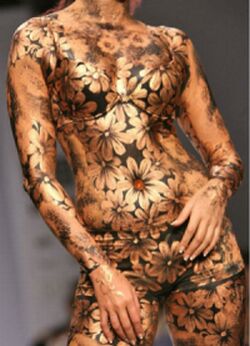Painting walls is an important part of painting your house. From cutting-in to rolling. This article is a brief summary of best practices for wall painting focusing on cutting-in and general brush usage. The way to paint a wall is to do the edges first (cutting-in) and then fill in the middle. There are a few different methods of cutting-in but the most popular is using a brush. When applying paint with a brush it can be hard to get a straight line, but there are a few tricks to help you along the way.
 |
| http://free-bodypainting-pictures.blogspot.com/ |
 |
| http://free-bodypainting-pictures.blogspot.com/ |
First is loading your brush, when 'loading' your brush with paint it's important to make sure you've got enough paint on your brush. You don't want to over load it but you also don't want to be dry brushing. Stab your brush into the paint a few times to load it up, it will quickly fill up with paint, glide your brush over the edge of the can to remove excess. It's important to make the distinction between squeezing it against the edge and gliding it against the edge; the goal is to remove just the outside paint and you do not want to squeeze out the inner-paint, this is the paint you are going to apply to the wall.
 |
| http://free-bodypainting-pictures.blogspot.com/ |
 |
| http://free-bodypainting-pictures.blogspot.com/ |
Brush control is very important and comes with experience, however, there are a few things you can actively do to improve your performance. Always use your full arm when controlling the brush, you paint using your shoulder and not your elbow or wrist. Using your body in this way helps to maintain a better overall control of the brush allowing you the paint a straight line on that wall. It also helps you to complete
your painting work faster and reduces overall strain from the repetition of painting. Another trick I've used when cutting-in is to exhale slowly as you bring your brush in-line with the cut. This not only increases your focus and concentration on the task at hand (painting the wall) but serves to relax your body at the same time, increasing your painting accuracy and thereby your overall painting efficiency.
 |
| http://free-bodypainting-pictures.blogspot.com/ |
 |
| http://free-bodypainting-pictures.blogspot.com/ |
Sometimes you run into the problems when cutting-in the wall, typical problems vary but these are minor situations such as too much paint in one spot that creates runs and drips or you've got a spider that's trying to get involved in the painting project. Typically when you've got too much paint on a spot it's because you haven't back brushed the area properly, or you've overloaded your brush. When applying the paint always use a minimum of three strokes. First stroke is from the dry wall back into the fresh paint, the next stroke is back out of the previously painted spot back to where you started and past that point, and the last stroke is back into the wet paint (back brush) past where your initial stroke went. Usually you'll do more than three strokes to fully spread the paint but the important part is the final stroke back into the wet paint, this is more important than just to spread the paint and essentially 'combines' the whole painted surface. With a strict practice in hand you can help to minimize these sort of paint problems.
Related article about :
Painting Walls - Paint Brush Tips & Tricks






















No comments:
Post a Comment